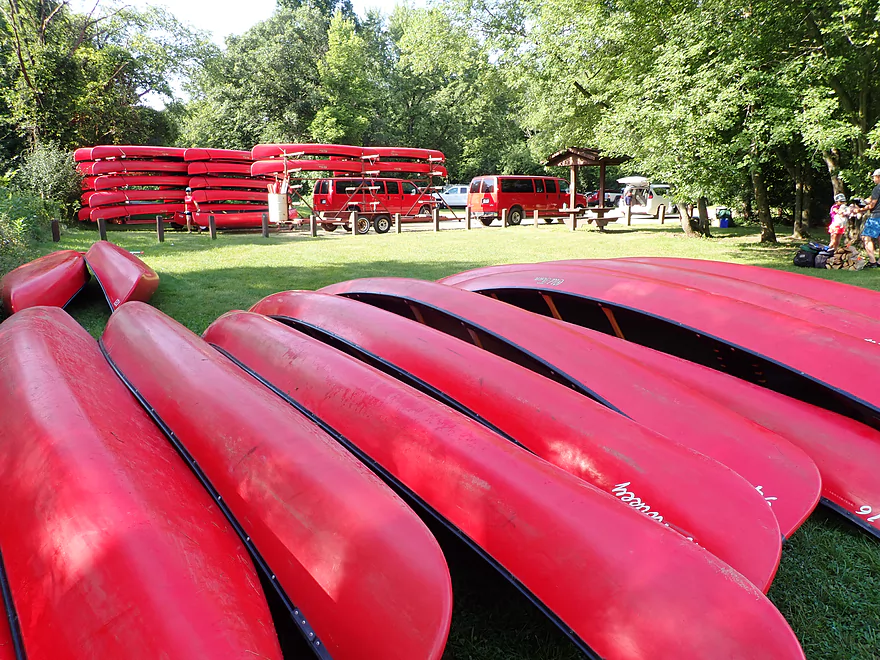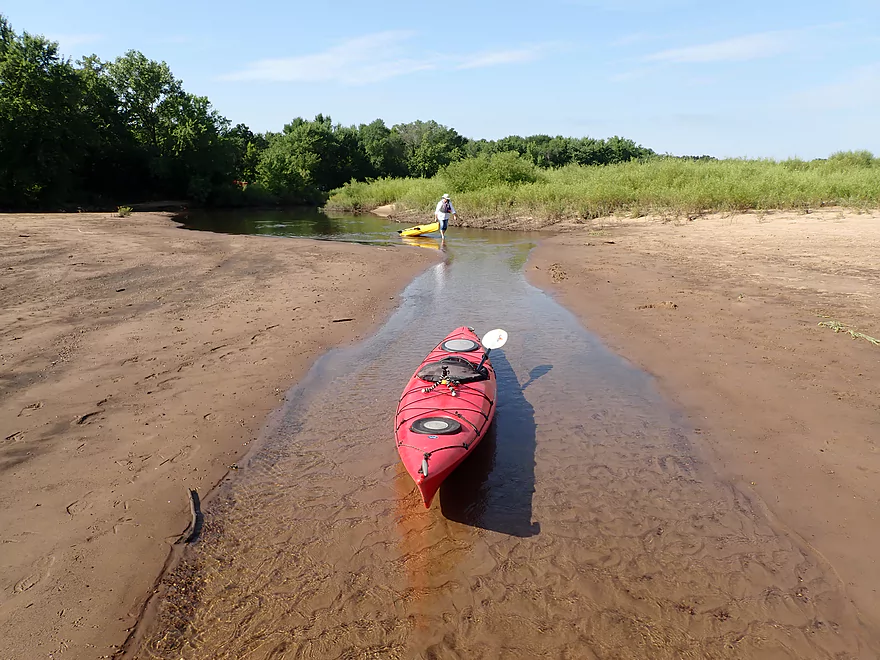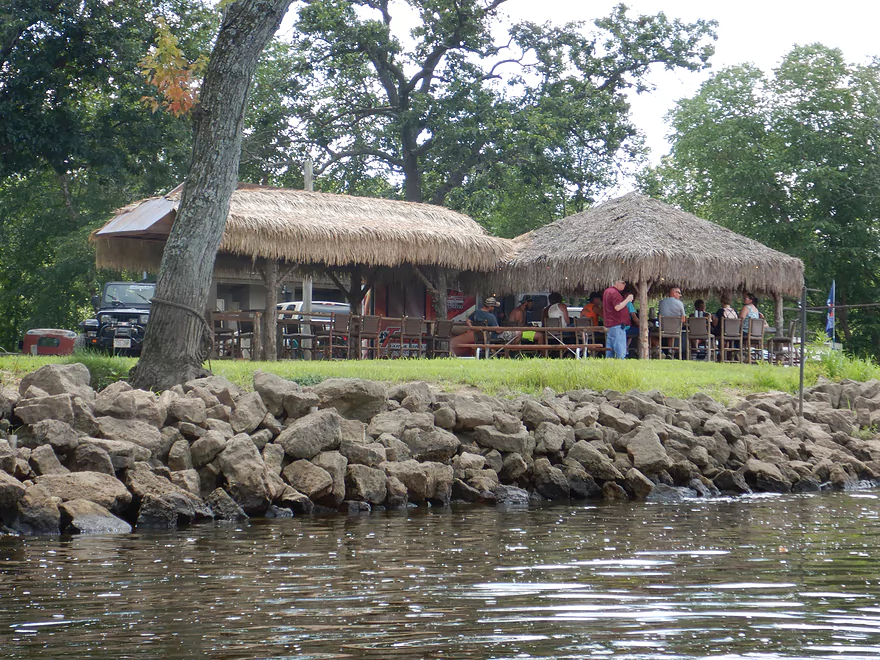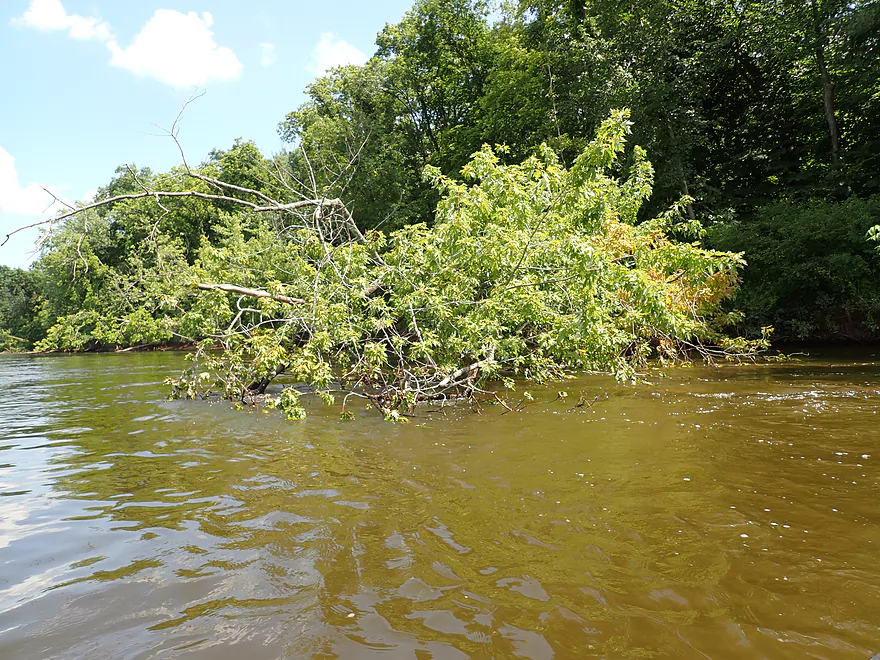Wisconsin River – Arena to Spring Green






The Lower Wisconsin River is a paddling classic and THE most popular water trail in the entire state. Unfortunately these past few years, it’s run atypically high and scared many would-be paddlers away, including yours truly. When finally I got a favorable weather forecast that included no headwind and a flow rate below 10,000 CFS, I jumped at the opportunity.
I’ve paddled the Wisconsin many times before and did want something new…so for this leg I settled on Arena to Spring Green. No, it doesn’t have rock outcrops, massive sand banks, or the many bluffs that other legs have. But…it does have one of the highest sandbar densities on the entire river (if not the state), and is one of if not the most popular paddles on the Lower Wisconsin.
We started the trip at the Arena Public Landing, which is a great launch. Interestingly enough, a huge sandbar has mostly sealed in the landing. If the water is high enough you can backtrack upstream and get on the main channel closer to Black Earth Creek….otherwise you’ll need to portage the sandbar (not a big deal). The unexpected advantage of the Arena landing being partly sealed in is that it does deter noisy powerboaters from using this stretch of the river.
While there aren’t many bluffs on this leg, there are still some nice ones along the north shore that are quite striking. Another nice attribute of this leg are the large wooded banks that are mostly undeveloped. This is somewhat remarkable and is mostly thanks to the conservation efforts of the Lower Wisconsin State Riverway. This was a unique bi-partisan project set up 30 years ago which protects 92 miles of the lower river for public enjoyment. The few houses you see along the shoreline were either grandfathered in or were developed with some sneaky loophole.
The highlight of the trip though are the many sandbars. Not many rivers in the Midwest will have this many or this high quality. This is one of the premier camping stretches for canoe camping, and we did see our fair share of tents and loaded canoes.
There were also several large islands with side channels that were fun to explore. In one case we followed a canoe up a side channel…and it continued for two miles! Paddling this side slough was a completely different experience compared to the main channel…and was more like paddling another river altogether. I personally enjoyed this little backwater adventure, but note these side channels won’t be to everybody’s liking. The main channel will have all the sandbars and the best bluff vistas….if you go sloughing…you miss that. Also some of these side sloughs get thirsty in low water and you can find yourself walking more than you anticipated.
We finally re-entered the main channel just past Trader’s Island Campground. Trader’s is a noteworthy operation that services a significant number of canoe rentals and liveries, and they do have their own private landing nearby. Once on the main channel, things started to change again. From here activity on the river picked up as we started to see powerboaters, large flotillas, and some large beach parties.
Past a scenic railroad trestle, we came to Hwy 14 which was our take-out. In summary, this was a great trip for the aforementioned bluffs, sandbars, and lack of development. The current was also very nice (despite the shallow grade), and we made good time by staying on the deeper/faster sides of the river. I can’t give this trip five stars as other Wisconsin River trips have been better, but it was still a good trip and should definitely be a major consideration for paddlers planning a sandbar camping trip.
A few flopping fish, a pair of cranes , some clams, and a few tame seagulls (I wonder if campers feed them). The highlight were the many turtles…it’s been a down year for seeing them on trips, but we saw more on this trip than all other trips this year combined.
We started at the Arena Landing which is a large public access and very nice. Outhouses are available and parking is free…but this landing can become crowded on weekends. A large sandbar has partly sealed in the landing which may require some creative paddling or a sandbar portage to reach the main channel (depending on depth).
There are numerous alternative upstream access options…but none nearby. The Mazo and Ferry Bluff landings are 6 and 9 miles upstream, and likely are only practical for a Spring Green trip if you plan on camping overnight. For a somewhat complete list of of access options on the Lower Wisconsin see my overview map.
We took out at the public Hwy 14 landing above Spring Green. This like the Arena landing is also popular and very nice…but it is a bit smaller, busier, and you do have to compete with motorboats. On weekends the main lot easily fills up, and people will park on the shoulder of the access road.
Trader’s Landing is an alternate access located 1.7 miles upstream. This is private though and you must pay $5 to use it.
Just 2.2 miles downstream from the Hwy 14 landing is Peck’s Landing. This is likely the largest and most popular canoe landing on the entire Wisconsin River (if not the entire state). There is a massive overflow parking lot and that too can fill with cars. The advantage of taking out at Peck’s (instead of Hwy 14), is that the additional two miles are quite scenic. Highlights include a Frank Lloyd Wright building, huge sandbars, and sandstone outcrops.
Bike Shuttle: The bike shuttle would be pretty long at 8.8 miles. If you do shuttle, it is advised to avoid busy Hwy 14 and to use Helena Road instead. That would be a relatively low traffic route and have few hills.
Commercial Shuttles and Liveries: There are many livery and rental services to choose from:
- Bender’s Bluff View Canoe Rental: 608-544-2906 – E10032 Huerth Rd, Sauk City, WI 53583
- Jensen’s Blackhawk River Runs: (608) 643-6724 – PO Box 57 Sauk City, WI 53583
- Sauk-Prairie Canoe Rental: (608) 375-5300 – 7554 US HWY 12, Sauk City, WI 53805
- Traders Bar and Grill (aka Sandbar Canoe Rental): (608) 588-7282 – 6147 Highway 14, Arena, WI 53503
- Waz Inn: 608-583-2086 – 234 S. Oak St., Lone Rock, WI 53556
- Wisconsin Canoe Company: (608) 432-5058 – E5016 US Hwy 14, Spring Green, WI 53588
- Wisconsin Riverside Resort: (608) 588-2826 – S13220 Shifflet Rd, Spring Green, WI 53588
Strainers: Along the wooded banks there are strainers in fast current that can be trouble if you get too close.
Wind: This can be a big problem. Know the forecasted wind speed and direction…a headwind of 8+ mph is a problem…a headwind of 15+ mph is a trip stopper.
Current: This is deceptively fast. Often one side of the river will be very slow while the other side has a fast chute. If you navigate the currents right, you can make good time.
Life Jackets: There are free loaners for kids at all major landings. Adults may want to consider wearing these too as the Wisconsin is a deceptively dangerous river with many hidden drop-offs, undertows, and hidden currents.
Depth Changes: Note for campers…the Prairie du Sac dam does do occasional sudden releases. Be mindful of this when choosing a tent location.
There is a gauge located downstream at Muscoda. Generally speaking, lower is better for the sandbars. Traditionally it usually takes until July for river levels to come down far enough for good sandbars to appear. September and October are usually the most shallow and are exceptional times to paddle the river. During this time, the sandbars will be fantastic and there will be far fewer paddlers on the river.
- 2,000-3,000 CFS: Very rarely does the river get this low, but if it does, you’ll have sandbar heaven. Yeah, some walking might be required but it shouldn’t be too bad.
- 3,001-5,000 CFS: Very ideal conditions with great sandbars. Low levels should scare away noisy motor-boaters as well.
- 5,001-7,500 CFS: A common depth and an ok conditions for sandbars.
- 7,501-10,000 CFS: Much smaller sandbars but still viable for camping. This trip was done at 9400 CFS.
- 10,001-12,500 CFS: Only the tops of the largest sandbars will be available. Camping is possible, but there could be competition for good spots.
- 12,501-15,000 CFS: Likely only a few sandbars. Water quality will also likely be somewhat murky and dirty at these levels (not a good time for swimming)
- 15,001-20,000 CFS: River will be very high, pushy, and somewhat muddy.
- 20,001+ CFS: Strong currents and strainers can be a serious hazard. This is too high IMO.
Quick Overview
- Upstream of Stevens Point: I don't have information yet on these stretches.
- Stevens Point to Lake Petenwell: ~42 miles. This stretch in Central Wisconsin used to have many natural rapids, but most have been buried under 8 dams, some of which are now difficult portages. Despite this there is still some good paddling to be had in this region.
- Lake Petenwell: 14.9 miles. This is a large flowage lake that is challenging for paddlers because of frequent strong winds and big waves.
- Castle Rock Lake: 14.5 miles. Another large flowage lake that is likely too big for enjoyable paddling.
- Castle Rock Lake Dam to Lemonweir River: 9.4 miles. This pre-Dells leg isn't elite, but is a pleasant stretch.
- Lemonweir River to Indian Trails Landing: 21.7 miles. This includes the famous Upper Dells and Lower Dells which feature many scenic sandstone outcrops.
- Indian Trails Landing to Portage: 16 miles. This is an overlooked section sandwiched between the Dells and Portage. While the scenery isn't top-notch, it does have many sandbars and few people which is a nice combination.
- Portage to Lake Wisconsin: 14.3 miles. This is a neat stretch of the river with many sandbars and cliffs, but the shoreline is very developed and motorboat traffic can be heavy on weekends.
- Lake Wisconsin: 14.5 miles. This is a challenging lake for paddling because of the huge and frequent waves created by motorboats.
- Prairie du Sac Dam to Port Andrews: 57 miles. This is the first half of the famous Lower Wisconsin Riverway. This is a super popular stretch for paddlers with the highlights being large sandbars, big bluffs, occasional cliffs, and fun side sloughs to explore.
- Port Andrews to Wyalusing: 40 miles. This is the second half of the Lower Wisconsin Riverway which has far fewer paddlers and sandbars. But the bluffs and sloughs are larger and more interesting.
Detailed Overview
- Upstream of Merrill: I don't have enough information yet on these legs to comment.
- Merrill Dam to Riverside Park: 0.5 miles. Might include some light rapids below the dam.
- Riverside Park in Merrill to Wisconsin River Forest Landing: 8.6 miles. A good prospect.
- Wisconsin River Forest Landing to Brokaw Boat Landing: 5.7 miles.
- Wisconsin River Forest Landing to Jesse Park: 1.4 miles. A terrific stretch with small boulder gardens, one set of Class 1-2 rapids, gravel bars and a nice sand bank.
- Jesse Park to Brokaw Boat Landing: 4.3 miles. A good stretch with scenic wooded banks and occasional gravel bars.
- Brokaw Boat Landing to Gilbert Park: 5.1 miles. River slows down and becomes hillier. This stretch is an ok prospect and goes past the old Brokaw paper plant that has been shut down. Paddlers must navigate Class 1 rapids and 2' drop where the old Brokaw dam used to be.
- Gilbert Park to Wausau Boat Dock: 1.5 miles. An impounded stretch through Wausau. There are numerous alternate access options to choose from.
- Wausau Boat Dock to Oak Island Boat Ramp: 1.2 miles. A nice stretch that includes Barkers Island and Isle of Ferns Park. But the Wausau dam does require a portage. This stretch parallels the famous Wausau Whitewater Park.
- Oak Island Boat Ramp to Rothschild Dam Access: 5.8 miles. Likely mostly uninteresting flowage paddling. There are many alternate access options to choose from.
- Rothschild Dam Access to Zimpro Park: 1.0 miles. This might be a nice stretch.
- Zimpro Park to River Road Boat Landing: 7.6 miles. The first half of this leg is likely nice river paddling, but the second leg is probably just an uninteresting flowage.
- Chucks Landing/Mosinee Dam to Bean's Eddy Boat Landing: 2.8 miles. Likely a nice leg. You might be able to launch by the dam where there should be some nice rapids and boulders.
- Bean's Eddy Boat Landing to Seagull Boat Landing: 5.1 miles. Mostly uninteresting flowage paddling. Although there might be some nice sand banks on the eastern shore.
- Seagull Boat Landing to Dubay Dam Access: 5.3 miles. Mostly uninteresting flowage paddling.
- Dubay Dam Access to River Road Landing: 5.5 miles. This could be a nice stretch of river.
- River Road Landing to Old US 10 Landing: 2.3 miles. Likely an ok leg.
- Old US 10 Landing to Stevens Point Dam: 5.6 miles. Probably uninteresting flowage paddling. Many alternate access options closer to Stevens Point.
- Stevens Point Dam to Blue Heron Boat Landing: 4.2 miles.
- Steven Point Dam to Whiting Dam: 2.6 miles. Starts slow and uninteresting, but the river becomes very scenic after the Hwy HH bridge. The rock formations below both dams are very striking. Many alt access points.
- Whiting Dam to Kimberly Clark Dam/Al Tech Park: 0.6 miles. Incredible scenery with exposed bedrock and boulder gardens below the Whiting Dam. Some rapids, but nothing major. The Kimberly Clark Dam is a dangerous low-head dam and should be treated carefully.
- Kimberly Clark Dam to Blue Heron Landing: 1.0 miles. Class 2 rapids below the dam, but after that the river slows dramatically and splits into many sub-channels and islands. Round trips on this leg are possible. I chose the far western channel where there were some nice rocky stretches.
- Blue Heron Landing to Mill Creek Landing: 4.1 miles. Likely a mediocre paddle with nothing special. Galecke Park is an alternate access.
- Mill Creek Landing to Biron Dam North Gate: 7.6 miles. Mostly uninteresting flowage paddling. Several alternate access options on route.
- Biron Dam North Gate to Veteran's Memorial Park: 4.5 miles.
- Biron Dam North Gate to Biron Landing: 1.0 miles. Super scenic stretch by two islands with many granite boulders.
- Biron Landing to Legion Park: 3.0 miles. A nice stretch by Big Island. The west channel is more undeveloped...but the east channel has several scenic granite islands.
- Portage through Legion Park: 680'. A steep wall separates the park from the river but in two locations the wall is short enough to get over (see map). Paddlers may want to consider a longer portage to bypass some of the shallow rocky stretches by Legion Park.
- Legion Park to Veteran's Memorial Park: 0.4 miles. A scenic stretch that features a large boulder field and the powerhouse of a large paper mill.
- Veteran's Memorial Park to Port Edwards Landing: 3.8 miles
- Veteran's Memorial Park to Demitz Park: 0.8 miles. A pleasant stretch that includes Belle Island.
- Demitz Park to Ben Hansen Park: 1.2 miles. This leg goes by Garrison Island and Edwards Island. Lyon Park is located across the river from Demitz Park and is another access option.
- Ben Hansen Park to Port Edwards Landing: 1.8 miles. Nice prospect that includes paddling past some historic islands. The Centralia dam should be an easy portage (east bank by golf course).
- Port Edwards Landing to Nekoosa/Riverside Park: 3.6 miles.
- Port Edwards Landing to Port Edwards Powerhouse: 1.3 miles. A half-mile portage is required. A very scenic boulder field is located below the dam. At high levels, the rocks are submerged and produce a half mile stretch of rapids (some strong).
- Powerhouse to Moccasin Creek Landing: 1.8 miles. A generic wooded stretch that isn't super interesting.
- Moccasin Creek Landing to Riverside Park: 0.5 miles. During the Nekoosa dam drawdown, this stretch had nice boulder fields and rapids.
- Riverside Park to Hwy 73: 0.8 miles. An ok stretch of the river. There are scenic cliffs south of Hwy 73, but these are past the dam warning line. Hwy 73 is not a good access option.
- Hwy 73 to Point Basse Ave (Portage of the Nekoosa Dam): 1.5 miles. A difficult 1.5 mile portage through downtown Nekoosa. Don't try to portage the south bank. There is a steep hill, cliffs, and large Domtar paper mill fences to deal with.
- Point Basse Ave to Jim Freeman Memorial Boat Landing: 0.8 miles. A generic stretch going by historic Point Basse. If you're willing to backtrack to the dam, you can see scenic boulder fields (during low flows) and a few cliffs. Point Basse Ave is a somewhat speculative access, but it seems public and doable for launching.
- Jim Freeman Memorial Boat Landing to Plank Hill Small Boat Access: 2.0 miles. Generic stretch.
- Plank Hill Small Boat Access to 19th Drive Landing: 5.3 miles. Features two epic sand banks. The main channel has some minor sandbars. Several of the side sloughs can provide fun side adventures.
- 19th Drive to the Petenwell Dam: 14.9 miles. This is Lake Petenwell which is a large and challenging lake for paddling. Waves and strong winds are frequently an issue. But when calm there are nice sandbanks on the northwest shore, hidden sloughs, and large islands to explore. See the overview map for more info.
- Petenwell Dam to Ganter Lane Landing: 3.8 miles. This stretch isn't too impacted by dams and may have nice sandbars at low levels.
- Ganter Lane Landing to Castle Rock Lake Dam: 10.7 miles. Castle Rock Lake is likely too big (wind/waves) for enjoyable paddling. There are many alternate launch options along the shore.
- Castle Rock Lake to the Lemonweir River: 10 miles. An ok section.
- Lemonweir River Mouth to River Bay Landing: 7 miles. The first half of the classic Upper Dells.
- River Bay Landing to Blackhawk Island: 6.5 miles. Second half of the classic Upper Dells known for its fantastic outcrops. Note, the Blackhawk Island landing is no longer accessible without special permission from the local 4H club.
- Black Hawk Island to Wisconsin Dells Dam: 2.0 miles. More nice sandstone outcrops. You can take out at a public ramp off Indiana Ave or portage the dam and take out SW of the dam by a launch off Wisconsin Dells Pkwy/Hwy 12.
- Dells Dam to Indian Trails Landing: 6.2 miles.
- Dells Dam to Newport Park: 2.2 miles. This is the heart of the famous Lower Dells with many scenic outcrops. Unfortunately jet boats are a serious plague on this stretch.
- Newport Park to Indian Trails Landing: 4.0 miles. Features the famous "Sugar Bowl" and four super cool caves. The outcrops soon disappear and this stretch is mostly uneventful (but peaceful) big river paddling.
- Indian Trails Landing to Pine Island Boat Ramp: 9.8 miles. Few paddle this stretch as it isn't as interesting. But...it does have a good concentration of sandbars and few competing paddlers for them.
- Pine Island Boat Ramp to Portage/Hwy 33 Access: 6.0 miles. Not an elite section that is lacking in cliffs and bluffs. It does have good sandbars though.
- Portage to Dekorra Park: 7.7 miles
- Portage to Baraboo River/Thunderbird Road: 5.2 miles. A good section with great sandbars. Close to Portage there are few motorboats.
- Baraboo River to Dekorra Park: 2.5 miles. River splits around massive Lib Cross Island. West channel has nice sandbars. St Lawrence Bluff has scenic sandstone outcrops and includes a cave you can paddle into.
- Dekorra Park to James Whalen Memorial Park: 6.6 miles.
- Dekorra Park to Camp Rest Park: 5.1 miles. A terrific section with rock outcrops, large island deltas, hidden sloughs, and nice sandbars. Unfortunately this part of the river is popular with motorboats and jet skis which can be a plague. Multiple alternate access options.
- Camp Rest Park to James Whalen Memorial Park: 1.5 miles. Not a great section because of the open water paddling, powerboats and big waves. The west shore though does have nice outcrops.
- James Whalen Memorial Park to Merrimac Memorial Park: 4.4 miles. River turns into "Lake Wisconsin". Generally speaking this isn't ideal for kayaking as motorboat traffic can be heavy and waves can be surprisingly big. Most direct route is the north shore which has a few bluffs, but generally speaking isn't that interesting.
- Merrimac Memorial Park to Veterans Memorial Park/Prairie du Sac: 9.6 miles.
- Merrimac Memorial Park to Moon Valley Landing: 3.3 miles. Includes a lot of developed shoreline. The ferry, railroad bridge, and Moon Bay are highlights.
- Moon Valley Landing to Veterans Memorial Park/Prairie du Sac: 6.3 miles. Other than Moon Bay and the dam, this is a boring stretch. There are numerous alt access options on this route.
- Prairie du Sac to Mazomanie: 8 miles. An ok section of the Wisconsin but lacking in sandbars.
- Mazomanie to Arena: 9.7 miles. A great section with nice sandbars and scenic bluffs.
- Arena to Hwy 14: 8.0 miles. Good section with a high concentration of sandbars. One of the more popular legs on the Lower Wisconsin.
- Hwy 14 to Hwy 23/Spring Green: 2.2 miles. Neat mini-section with sandstone outcrops. Very popular in the summer.
- Spring Green to Lone Rock: 7.4 miles. Another fine sandbar/bluff section with some nice rock outcrops too.
- Lone Rock to Gotham: 8 miles. This stretch has super impressive rock outcrops and sand banks.
- Gotham to Muscoda: 7.6 miles. This leg includes more large sandbars and great outcrops. Bonus highlights include fast current and not seeing as many people.
- Muscoda to Port Andrew: 7 miles. A good stretch with many islands and sandbars.
- Port Andrew to Boscobel: 9 miles. Wooded islands start to get massive.
- Boscobel to Woodman/Big Green River: 9 miles and start of the less paddled stretch of the Lower Wisconsin. Far fewer sandbars from here to the mouth, but good bluffs and side sloughs to explore.
- Woodman to Adiantum Woods State Natural Area: 3.9 miles. Good stretch with large islands.
- Adiantum Woods State Natural Area to Millville: 3.8 miles. Good stretch with large bluffs and sandbars.
- Millville to Bridgeport: 5.3 miles. A peaceful stretch with few paddlers, yet good river bluffs and islands.
- Bridgeport to Wyalusing (the mouth): 9 miles.
























































She is the address of the Hwy 14 Takeout landing in Spring Green?
Thanks, Sean Tanner
I’m not sure…I think Google just calls it the Spring Green Boat Launch